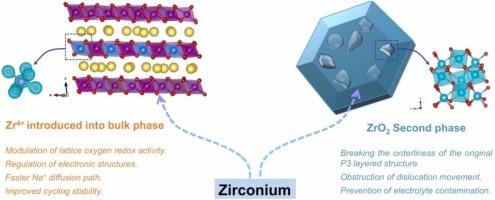当前位置:
X-MOL 学术
›
Nano Energy
›
论文详情
Our official English website, www.x-mol.net, welcomes your
feedback! (Note: you will need to create a separate account there.)
A two-pronged approach:Bulk-phase substitution and second-phase synergism to enhance the anion redox stability of layered oxide cathode for sodium-ion batteries
Nano Energy ( IF 16.8 ) Pub Date : 2024-10-30 , DOI: 10.1016/j.nanoen.2024.110430 Baorui Chen, Yuhang Xin, Yingshuai Wang, Xiangyu Ding, Chunyu Jiang, Yanfei Pang, Hongfeng Liu, Feng Wu, Hongcai Gao
Nano Energy ( IF 16.8 ) Pub Date : 2024-10-30 , DOI: 10.1016/j.nanoen.2024.110430 Baorui Chen, Yuhang Xin, Yingshuai Wang, Xiangyu Ding, Chunyu Jiang, Yanfei Pang, Hongfeng Liu, Feng Wu, Hongcai Gao

|
As a supplement to lithium-ion batteries, sodium-ion batteries have great application potential in large-scale energy storage equipment, vehicle start-stop power supplies, and low-speed electric vehicle power. P3-Nax y 1-y O2 (NLMO), has received widespread attention due to its higher charge voltage and discharge capacity. However, poor cycle stability and rapid voltage platform decay caused by the release of oxygen during charging hinder its practical application. This paper reports a new NLMO modification strategy, which effectively improves the cycling stability of NLMO by substituting Zr4+ for Mn4+ in the bulk phase to suppress the O2− /On− redox couple activity and stabilize the ZrO2 second phase lattice. Under the combined action of substitution and second phase, the capacity retention rate of NLMO@Zr0.15 was 85.4 % after 100 cycles at a rate of 5 C. The results show that Zr4+ changes the coordination environment and electronic structure of O in the crystal lattice, prompting further splitting of Mn t2 g , thereby increasing the proportion of Mn 3d orbitals near the Fermi level. During the first discharge process, due to the charge balancing effect, Mn3+ /Mn4+ replaced the electrochemical activity of O2− /On− , obtaining a specific capacity of up to 161 mAh g−1 . This internal and external improvement idea provides a new direction for solving the poor cycle stability of NLMO high specific energy sodium-ion battery cathode materials and improving the specific capacity.
中文翻译:

双管齐下的方法:体相取代和第二相协同作用,以增强钠离子电池用层状氧化物阴极的阴离子氧化还原稳定性
钠离子电池作为锂离子电池的补充,在大型储能设备、车辆启停电源和低速电动汽车动力方面具有巨大的应用潜力。P3-NaxLiyMn1-yO2 (NLMO) 因其较高的充电电压和放电容量而受到广泛关注。然而,充电过程中氧气释放引起的循环稳定性差和电压平台快速衰减阻碍了其实际应用。本文报道了一种新的 NLMO 修饰策略,通过在体相中用 Zr4+ 代替 Mn4+ 来抑制 O2−/On− 氧化还原偶活性并稳定 ZrO2 第二相晶格,从而有效提高了 NLMO 的循环稳定性。在替代和第二相的联合作用下,在 5 C 的速率下循环 100 次后,NLMO@Zr0.15 的容量保持率为 85.4 %。结果表明,Zr4+ 改变了晶格中 O 的配位环境和电子结构,促使 Mn t2 g 进一步分裂,从而增加了费米能级附近 Mn 3d 轨道的比例。在第一次放电过程中,由于电荷平衡效应,Mn3+/Mn4+ 取代了 O2−/On− 的电化学活性,获得了高达 161 mAh g−1 的比容量。这种内外改进思路为解决 NLMO 高比能钠离子电池正极材料循环稳定性差和提高比容量提供了新的方向。
更新日期:2024-10-30
中文翻译:

双管齐下的方法:体相取代和第二相协同作用,以增强钠离子电池用层状氧化物阴极的阴离子氧化还原稳定性
钠离子电池作为锂离子电池的补充,在大型储能设备、车辆启停电源和低速电动汽车动力方面具有巨大的应用潜力。P3-NaxLiyMn1-yO2 (NLMO) 因其较高的充电电压和放电容量而受到广泛关注。然而,充电过程中氧气释放引起的循环稳定性差和电压平台快速衰减阻碍了其实际应用。本文报道了一种新的 NLMO 修饰策略,通过在体相中用 Zr4+ 代替 Mn4+ 来抑制 O2−/On− 氧化还原偶活性并稳定 ZrO2 第二相晶格,从而有效提高了 NLMO 的循环稳定性。在替代和第二相的联合作用下,在 5 C 的速率下循环 100 次后,NLMO@Zr0.15 的容量保持率为 85.4 %。结果表明,Zr4+ 改变了晶格中 O 的配位环境和电子结构,促使 Mn t2 g 进一步分裂,从而增加了费米能级附近 Mn 3d 轨道的比例。在第一次放电过程中,由于电荷平衡效应,Mn3+/Mn4+ 取代了 O2−/On− 的电化学活性,获得了高达 161 mAh g−1 的比容量。这种内外改进思路为解决 NLMO 高比能钠离子电池正极材料循环稳定性差和提高比容量提供了新的方向。


















































 京公网安备 11010802027423号
京公网安备 11010802027423号